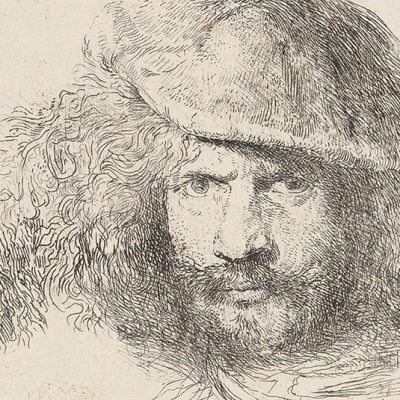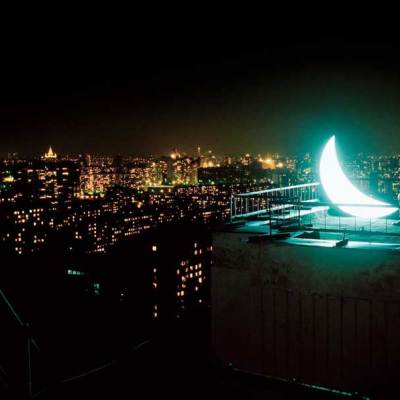‘Serge Poliakoff, Le Rêve des Formes’ opens with a vitrine of documentary material, ‘Poliakoff avant Poliakoff’. As well as a young Serge in fancy dress there are photos of his family of musicians and a concert programme. Poliakoff left Russia in 1917 with his aunt Nadia, a singer. He arrived in France in the 1920s and played guitar in cabarets to make a living. Alongside these documents is a nude study from 1922: the only figurative piece in the exhibition. Already the young artist’s sketch of a figure is reduced to lines and forms.
‘Every great painter works on a single theme’ Poliakoff wrote in Pensées. The Musée d’Art Moderne de la Ville de Paris’ retrospective is organised chronologically, chronicling the subtle shifts in Poliakoff’s exploration of abstraction, his own particular direction. In the early paintings, Composition abstraite aux traits (1946, private collection), and Espace orangé (1948, Musée des Beaux-Arts, Liège), lines mark sections across monochrome blocks.
But line is soon eclipsed by a concentration on form. Imperfect geometric forms start to interlock and overlap like fantasy Tetris blocks. Despite the unevenness of the forms the paintings are governed by an inner logic – Poliakoff often referred to the Golden Section – and the results are both dynamic and balanced.
Composition Murale (1965–7), Serge Poliakoff © Centre Pompidou, MNAM-CCI, Dist. RMN-Grand Palais / Droits réservés © ADAGP, Paris 2013

In video footage of Poliakoff from the late 1960s he identifies himself as being a Russian man in body, and a French painter in spirit (after 40 years in France he still has a marvellously thick Russian accent and manner which, according to his paint supplier ‘scares the ladies’). Poliakoff may have preferred to align himself with the French school, but late art historian John Russell claimed there is something very Russian in the artist’s colours. Colour is vital to Poliakoff’s reduced abstract constructions. Pure pigments are layered, giving depth to paintings, while transparent effects lend a vibrancy that challenges the solidity of form.
Poliakoff’s Russianness is apparent in Composition Murale (1965–7), an abstract interpretation of a Russian Orthodox iconostasis, harking back to his youth in Moscow. His early gouache paintings also take the theme of Danses Russes to create vivid semi-abstract works.
Other than the colourful whirling of the Danses Russes, the show is permeated by a feeling of calm. The abstract compositions are bold without being loud. They are self-sufficient but invite contemplation. This was the artist’s desire, as he said himself: ‘Quand un tableau est silencieux, cela signifie qu’il est réussi’ (‘When a picture is silent, that means it’s worked’).
‘Serge Poliakoff: Le Rêve des Formes’ is at the Musée d’Art Moderne de la Ville de Paris until 23 February 2014.



